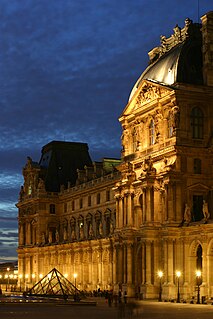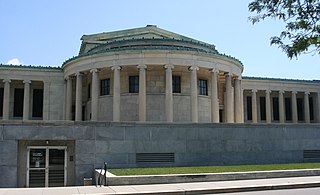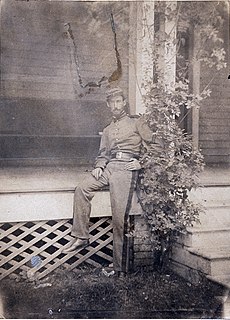
A museum is an institution that cares for (conserves) a collection of artifacts and other objects of artistic, cultural, historical, or scientific importance. Many public museums make these items available for public viewing through exhibits that may be permanent or temporary. The largest museums are located in major cities throughout the world, while thousands of local museums exist in smaller cities, towns, and rural areas. Museums have varying aims, ranging from serving researchers and specialists to serving the general public. The goal of serving researchers is increasingly shifting to serving the general public.

An art museum is a building or space for the display of art, usually from the museum's own collection. It might be in public or private ownership and may be accessible to all or have restrictions in place. Although primarily concerned with visual art, art museums are often used as a venue for other cultural exchanges and artistic activities, such as performance arts, music concerts, or poetry readings. Art museums also frequently host themed temporary exhibitions, which often include items on loan from other collections.
John Walker is an English painter and printmaker. He has been called "one of the standout abstract painters of the last 50 years."
Milton Clark Avery was an American modern painter. Born in Altmar, New York, he moved to Connecticut in 1898 and later to New York City.

The Saatchi Gallery is a London gallery for contemporary art, opened by Charles Saatchi in 1985 in order to exhibit his collection to the public. It has occupied different premises, first in North London, then the South Bank by the River Thames, and finally in Chelsea, its current location. Charles Saatchi's collection—and hence the gallery's shows—has had distinct phases, starting with US artists and minimalism, moving to the Damien Hirst-led Young British Artists, followed by shows purely of painting, and then returning to contemporary art from America in USA Today at the Royal Academy in London. A 2008 exhibition of contemporary Chinese art formed the inaugural exhibition in the new venue for the gallery at the Duke of York's HQ.

The Albright–Knox Art Gallery is an art museum located at 1285 Elmwood Avenue, Buffalo, New York, in Delaware Park. The Albright-Knox's Elmwood Avenue campus is temporarily closed for construction. It is currently hosting exhibitions and events at Albright-Knox Northland, a project space located at 612 Northland Avenue in Buffalo’s Northland Corridor. The new Buffalo Albright Knox Gundlach Art Museum (AKG) is expected to open in 2022.

The Freer Gallery of Art is an art museum of the Smithsonian Institution in Washington, D.C. focusing on Asian art. The Freer and the Arthur M. Sackler Gallery together form the Smithsonian's national museums of Asian art in the United States. The Freer and Sackler galleries house the largest Asian art research library in the country and contain art from East Asia, South Asia, Southeast Asia, the Islamic world, the ancient Near East, and ancient Egypt, as well as a significant collection of American art.

The American Folk Art Museum is an art museum in the Upper West Side of Manhattan, at 2, Lincoln Square, Columbus Avenue at 66th Street. It is the premier institution devoted to the aesthetic appreciation of folk art and creative expressions of contemporary self-taught artists from the United States and abroad.

Sanford Robinson Gifford was an American landscape painter and one of the leading members of the Hudson River School. Gifford's landscapes are known for their emphasis on light and soft atmospheric effects, and he is regarded as a practitioner of Luminism, an offshoot style of the Hudson River School.

A museum is distinguished by a collection of often unique objects that forms the core of its activities for exhibitions, education, research, etc. This differentiates it from an archive or library, where the contents may be more paper-based, replaceable and less exhibition oriented, or a private collection of art formed by an individual, family or institution that may grant no public access. A museum normally has a collecting policy for new acquisitions, so only objects in certain categories and of a certain quality are accepted into the collection. The process by which an object is formally included in the collection is called accessioning and each object is given a unique accession number.

Randolph College is a private liberal arts and sciences college in Lynchburg, Virginia. Founded in 1891 as Randolph-Macon Woman's College, it was renamed on July 1, 2007, when it became coeducational.
Art museums in the United States and the United Kingdom have been hit especially hard by the 2008–2012 global recession. Dwindling endowments from wealthy patrons forced some museums to make difficult and controversial decisions to deaccession artwork from their collections to gain funds, or in the case of the Rose Art Museum, to close the institution and sell the entire collection.

The Addison Gallery of American Art, as a department of Phillips Academy in Andover, Massachusetts, is an academic museum dedicated to collecting American art. The museum's purpose is to acquire, preserve, interpret, and exhibit works of art for the education and enjoyment of local, regional, national and international audiences, including the students, faculty, and community of Phillips Academy, and other students, teachers, scholars and the general public.
Stephen Westfall is an American painter, critic, and professor at Rutgers University and Bard College.

An exhibition, in the most general sense, is an organized presentation and display of a selection of items. In practice, exhibitions usually occur within a cultural or educational setting such as a museum, art gallery, park, library, exhibition hall, or World's fairs. Exhibitions can include many things such as art in both major museums and smaller galleries, interpretive exhibitions, natural history museums and history museums, and also varieties such as more commercially focused exhibitions and trade fairs.
Maier Museum of Art at Randolph College features works by American artists from the 19th through 21st centuries. Randolph College has been collecting American art since 1907 and the Maier Museum of Art now houses its collection of several thousand American paintings, prints, drawings, and photographs from the 19th and 21st centuries.

The Frances Young Tang Teaching Museum and Art Gallery is a part of Skidmore College and located in Saratoga Springs, New York.

Men of the Docks is an oil painting on canvas completed by the American artist George Bellows in 1912. Depicting the docks of New York City, this 114.3-by-161.3-centimetre painting was sold to the National Gallery in London in 2014 for $25.5 million.

Deaccessioning is the process by which a work of art or other object is permanently removed from a museum's collection to sell it or otherwise dispose of it.

Joe Wesley Overstreet was an African-American painter from Mississippi who lived and worked in New York City for most of his career. In the 1950s and early 1960s he was associated with the Abstract Expressionist movement.














